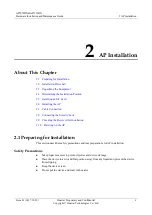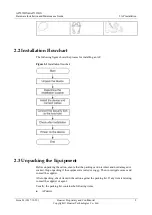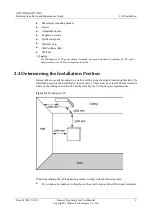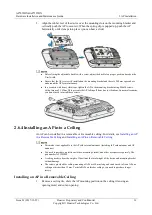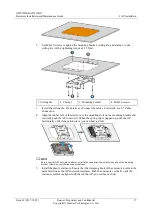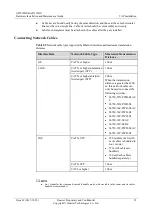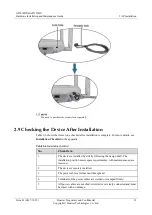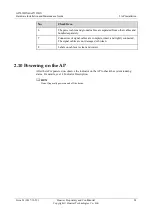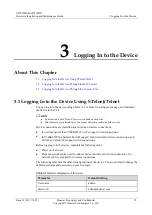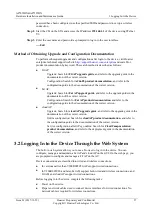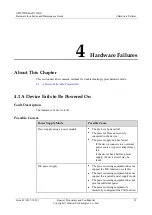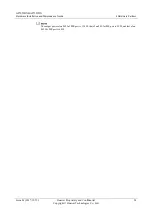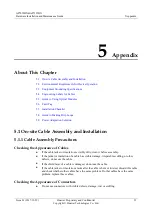
AP7052DN&AP7152DN
Hardware Installation and Maintenance Guide
2 AP Installation
Issue 01 (2017-12-29)
Huawei Proprietary and Confidential
Copyright © Huawei Technologies Co., Ltd.
20
Table 2-4
Cable connections
No.
Cable or Device Description
1
USB flash drive
or USB cable
Connects to a USB flash drive or other storage devices to
extend the storage space of the AP. The USB2.0 standard
is supported.
2
Network cable
The service network cable and PoE input cable cannot
be connected to the console port. Otherwise, the AP
may be damaged when using PoE power supply.
If the AP needs to connect to the Ethernet, ensure that
the Ethernet cable is working properly. If the Ethernet
cable is not working properly, for example, RJ45
connectors are short-circuited, the AP may fail to be
powered on or fail to work. Before connecting an
Ethernet cable to the AP, use the cable test tool to
check whether the cable is qualified. If the cable is
unqualified, replace it.
For the supported network cable types and length
requirements, see
3
DC power adapter When the AP uses the DC power supply, use a power
adapter for power supply; otherwise, the AP may be
damaged.
4
RF cable
Connects an antenna to an IoT card through a radio cable.
5
Antenna
Connects a 2.4 GHz or 5 GHz antenna to the AP to send
and receive wireless signals.The port type is N-type
female.The port is applicable only to an AP that supports
external antennas.
6
Antenna
Connects a 5 GHz antenna to the AP to send and receive
wireless signals.The port type is N-type female.The port
is applicable only to an AP that supports external
antennas.
No priorities are distinguished for DC and PoE power supply modes, DC and GE/PoE_IN support
HSB.
Two PoE channels have no priority and can serve as HSB for each other when they have the same
input power type.
When installing a cable, you must make a drip loop to prevent water from flowing into
devices along the cable. For the method of making the drip loop, see 5.8 Guide to Making
Drip Loops.
Pay attention to the following points when bundling the cables:
Different types of cables must be separately routed with the minimum spacing of 30 mm
and cannot be entangled or crossed. Cables should be parallel or separated using
dedicated separators.
Bundled cables are closely arranged, straight, tidy, and undamaged.

